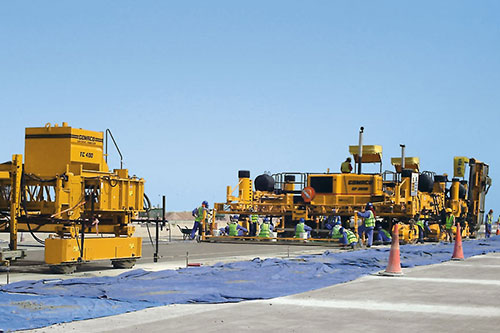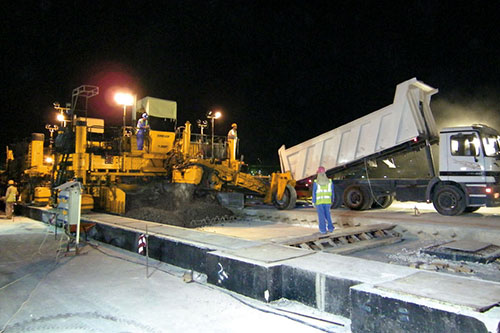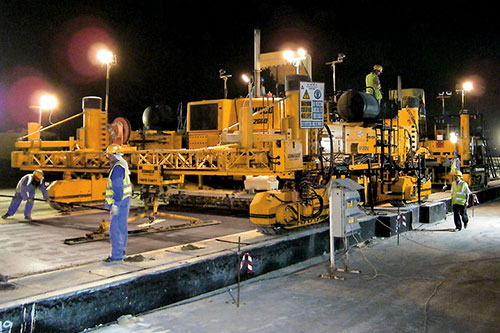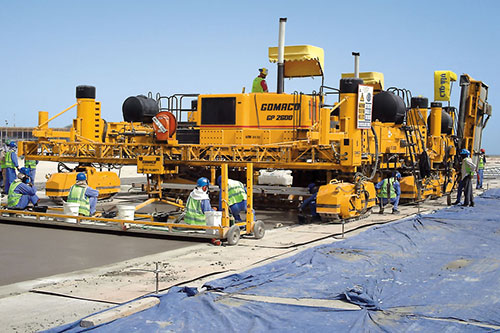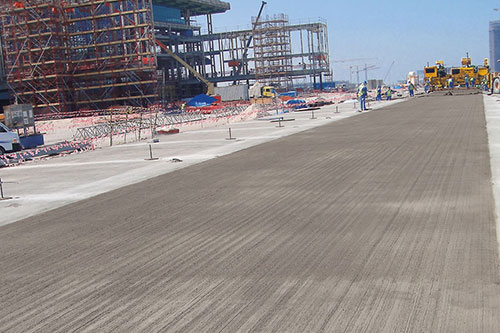GOMACO World Index --- GOMACO World 39.2 - November 2011
A GOMACO Paving Train Overcomes Challenges on the New Doha International Airport
A GOMACO PS-2600 placer/spreader, four-track GP-2600 paver and T/C-400 texture/cure machine at work on the New Doha International Airport in Qatar.
The country of Qatar, located on the Persian Gulf, developed a master plan to build a new replacement airport in their capital city of Doha, the New Doha International Airport, in 2003. Their goal is to have a facility capable of handling 50 million passengers, two million tons of cargo, and 320,000 aircraft landings and take-offs each year by 2015. Phase one of the aggressive project is scheduled for completion early next year.
The Tayseeir Contractors Company Joint Venture, including Consolidated Contractors International Company (CCIC), is one of the many contractors on-site finishing their share of the first phase. CCIC has been at work slipforming approximately 100,000 cubic meters (130,794 yd3) of new concrete aprons on the airport with their new GOMACO paving train. Their paving train includes a PS-2600 placer/spreader, four-track GP-2600 slipform paver with an Auto-Float® attachment, and a T/C-400 texture/cure machine.
Challenges abounded on the project, including an airport design plan which did not consider slipform paving, daytime summer temperatures averaging 40 degrees Celsius (104 degrees F), a crew new to slipforming, and varying paving widths and depths... all while working around hundreds of other contractors trying to complete their portion of the project.
The challenges caused CCIC and their Concrete Paving Manager Kevin Robinson to look at the project differently as they worked to maximize the utilization of their GOMACO paving train.
"The project was just an obstacle course with us having to go over or around lamppost bases, fire hydrants, fuel pits, electrical pits and all the other different types of pits," Robinson said. "We really had to be on top of our game and keep everything carefully coordinated and planned so we could put concrete on the ground every day with the GP-2600. That was our goal, to always get concrete on the ground. We were able to achieve that goal, even if we only paved 200 cubic meters (262 yd3) that day."
CCIC slipformed the new airport's aprons on a 100 millimeter (4 in) thick asphalt base applied over a rock subbase. The Portland Cement Concrete (PCC), without air entrainment, was produced on site by three different mobile batching plants with the capacity to produce 100 to 110 cubic meters (131 to 144 yd3) of concrete per hour. Slump averaged between 25 to 35 millimeters (1 to 1.4 in).
Concrete was delivered to the paving site by dump trucks carrying eight cubic meter (10.5 yd3) loads. The trucks dumped their load onto the belt of the PS-2600 placer/spreader working in front of the GP-2600 paver. Or, when project logistics didn't allow enough room for the PS-2600, concrete was dumped directly on the grade.
The GP-2600 paved a maximum of six meters (19.7 ft) wide on the project and up to 550 millimeters (21.7 in) deep. Baskets were placed on grade every six meters (19.7 ft).
"There was a grated water trench just inside the aprons that varied in size in different areas, so we had to alter the width of the paving equipment nine different times to suit the design," Robinson said. "On any other project we'd be able to pave 2000 cubic meters (2616 yd3) per day, but this one was just so difficult. The most we ever accomplished was 856 cubic meters (1120 yd3). It's all due to the difficult areas of design, which would have up to 20 headers and footers per shift, as we paved around the various obstacles."
A T/C-400 texture/cure machine followed the paver applying a burlap drag finish, transverse tine and white spray cure. Contraction joints were sawed into the new slab every six meters (19.7 ft). Expansion joints were placed every 75 meters (246 ft).
"The paving crew when we first started were very inexperienced, but now I would rate them as good as anyone I know," Robinson said. "The GP-2600 performed very well through all of it and the crew learned quickly how to work on and around the GOMACO equipment. We met all of the tolerances specified by the engineers and the paver laid the concrete as flat as you can get. I'm really proud of the concrete we produced in such challenging conditions."
CCIC is currently finishing up their portion of the concrete pavement at the New Doha International Airport. Some hand pours and a few other details are all that is left to complete. The GOMACO paving train and Robinson have already moved onto another project, Muscat International Airport in Muscat, Oman. The GP-2600 is at work slipforming approximately 140,000 cubic meters (183,112 yd3) of stands and aprons as part of the airport's expansion project.
Obstacles in the new apron, such as lamp post bases and electrical pits, created logistical challenges for CCIC while working on the airport project.
New Doha International Airport (NDIA) Facts:
(Information courtesy of airport-technology.com)
• The current airport handles 4.2 million passengers a year, whereas the new airport will be able to handle 12.5 million passengers a year after the first phase is completed.
• NDIA will be approximately two-thirds the size of the city of Doha and 12 times larger than the old airport.
• Over half of the area of the new airport (located on the Persian Gulf) will be built on land reclaimed from the sea, amounting to 28.2 square kilometers (10.9 mi2).
• Land reclamation required more than 62 million cubic meters (81,092,938 yd3) of "fill" to complete.
• Thirteen kilometers (8.1 mi) of new armored seawall protect NDIA.
• Contractor congestion was created as everyone worked at the same time to complete an 85 meter (279 ft) high control tower, a 510,000 square meter (609,955 yd2) passenger terminal with 40 gates, one cargo terminal, a 150,000 square meter (179,399 yd2) aircraft maintenance center, a separate terminal for the Emir of Qatar, and other facilities.
• When fully completed, NDIA will be able to service six A380-800 super jumbos simultaneously. The airport will be the first in the world purposely built to accommodate these aircraft.
The GP-2600 with Auto-Float® paved at various widths and thicknesses. Six meters (19.7 ft) wide and 550 millimeters (21.7 in) thick were the maximum paving dimensions.
Subscribe to Receive GOMACO World Magazine
